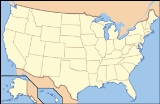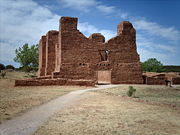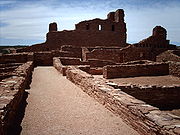
Salinas Pueblo Missions National Monument
Encyclopedia



New Mexico
New Mexico is a state located in the southwest and western regions of the United States. New Mexico is also usually considered one of the Mountain States. With a population density of 16 per square mile, New Mexico is the sixth-most sparsely inhabited U.S...
, near Mountainair. The main park visitor center is in Mountainair.
History
Once, thriving Native AmericanNative Americans in the United States
Native Americans in the United States are the indigenous peoples in North America within the boundaries of the present-day continental United States, parts of Alaska, and the island state of Hawaii. They are composed of numerous, distinct tribes, states, and ethnic groups, many of which survive as...
trade communities of Tiwa and Tompiro language
Tompiro Indians
The Tompiro Indians were Pueblo Indians living in New Mexico. They lived in several adobe villages east of the Rio Grande River Valley in the Salinas region of New Mexico. Their settlements were abandoned and they were absorbed into other Indian tribes in the 1670s.-Origin and Language:Very...
-speaking Puebloans inhabited this remote frontier area of central New Mexico. Early in the 17th century Spanish Franciscans found the area ripe for their missionary
Missionary
A missionary is a member of a religious group sent into an area to do evangelism or ministries of service, such as education, literacy, social justice, health care and economic development. The word "mission" originates from 1598 when the Jesuits sent members abroad, derived from the Latin...
efforts. However, by the late 1670s the entire Salinas District, as the Spanish had named it, was depopulated of both Indian and Spaniard. What remains today are austere yet beautiful reminders of this earliest contact between Pueblo Indians and Spanish Colonials: the ruins of three mission churches, at Quarai, Abó, and Gran Quivira and the partially excavated pueblo
Pueblo
Pueblo is a term used to describe modern communities of Native Americans in the Southwestern United States of America. The first Spanish explorers of the Southwest used this term to describe the communities housed in apartment-like structures built of stone, adobe mud, and other local material...
of Las Humanas or, as it is known today, the Gran Quivira pueblo.
It was first proclaimed Gran Quivira National Monument on November 1, 1909. As with all historic areas administered by the National Park Service, the National Monument was listed on the National Register of Historic Places
National Register of Historic Places
The National Register of Historic Places is the United States government's official list of districts, sites, buildings, structures, and objects deemed worthy of preservation...
on October 15, 1966. On December 19, 1980 it was enlarged and two New Mexico State Monuments were absorbed on November 2, 1981. It was renamed on October 28, 1988.

